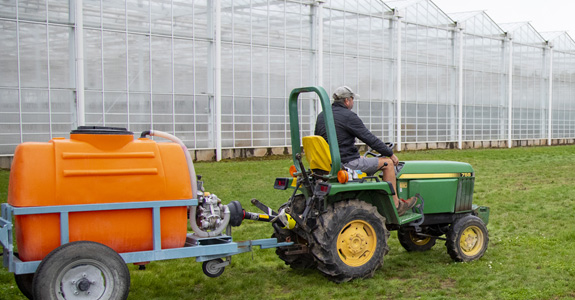Simple tactics to help safeguard your horticulture business from theft
For business owners like you, the threat of theft is an unfortunate reality. No business is immune. According to the National Association for Shoplifting Prevention (NASP), more than $13 billion worth of goods are stolen from retailers across the United States each year.
The immediate aftermath of a break-in or theft can be traumatic, but the time and financial cost as you recover may be the most difficult part. In addition to losing potentially irreplaceable items, you could experience disruptions in daily processes, delays in fulfilling customer orders, and negative impacts to your business's reputation.
Fortunately, theft prevention is feasible through employee training, proper processes, the right technology, and a proactive mindset. Consider adapting the following list of tactics to help you prevent theft at your greenhouse or garden center:
Train your staff
It's important to share theft prevention and response guidelines with your staff so they're informed and confident. Your staff is your business's front line to preventing theft.
Review your company's security policy annually. Everyone should know what to do when a robbery occurs or a theft is discovered.
Hold practice drills so your business's response process is near automatic in the event of an actual break-in or theft discovery.
Schedule at least two employees to open and close your business, and provide a step-by-step guide to activate and disarm your shop's security.
Encourage staff to report suspicious activity and to never try to handle a potentially dangerous situation.
Rely on tech, lots of it
Take inventory of your lights and video cameras, and add more if you identify vulnerable areas throughout your facility.
Lights and cameras:
Provide bright light, inside and outside, that floods doorways, windows, and large vents. Quickly replace any burnt-out bulbs.
Install motion-sensor security lighting to deter criminals from lurking in dark areas.
Add video cameras inside and outside. Focus cameras on entry points and cash registers.
Post security signage announcing you are surveilling the area. Signs are effective deterrents.
Security alarms:
Activate and monitor alarms when your business is closed.
Add motion-activated alarms inside buildings.
Install loud alarms and flashing lights on door entries. Loud noise and moving lights can instantly scare away criminals and alert the neighbors.
Abundantly post signs stating your business has security alarms.
Affix portable alarms to your assets and inventory.
Lock up vehicles and keys
Increase the degree of difficulty for prospective thieves to steal equipment, no matter where it's located.
Outside:
Avoid parking machinery within easy access to the road.
Place equipment in a lighted area surrounded with durable fencing and quality locks on gate doors.
Remove rotors, distributor caps, or batteries from motorized equipment stored outside for long periods of time.
Inside:
Remove keys from all equipment, regardless of how often you use it.
Lock up keys to vehicles. Create a monitored check-in and check-out process for all equipment keys.
Keep equipment storage areas neat and well-organized to easily notice inventory absences.
The Agricultural Crime Technology Information and Operations Network also suggests engraving owner-applied numbers to your equipment in a hidden spot with metal punches or brands to increase the likelihood of stolen property being identified and returned.
Keep the cash safe
Cash registers, safe deposit boxes, wooden boxes…whatever your cash intake system is, establish a cash removal process.
Regularly train employees on safety protocols when working with cash.
Set up an armored car system to make deposits during the day or create a process with your bank to make deposits outside its business hours when necessary.
Create a schedule for managers to verify cash balances, especially during peak shopping times.
Encourage customers to use electronic payments rather than cash to help minimize cash intake and storage.
Make sure you're covered with property insurance
While you can't predict when any individual attempt may occur, you can prepare for the possibility of theft in a general way. Commercial property insurance can help alleviate the worry of “what if” and help protect your greenhouse or garden center's physical assets.
Review your current policy to make sure your business and inventory are covered. If you have questions or would like to learn more about our commercial property coverages, contact us. We're here to help keep your horticulture business safe.
Related links:
You can reduce your workplace risks by cleaning up your property, inspecting your equipment, and reviewing your safety procedures. Learn more tips here.
If you experience a covered loss, follow these five tips when reporting your claim to help get your claim started, processed, and resolved more quickly.
Any business that relies on technology should be prepared for cyberattacks. This guide provides details about common types of cybercrime and how you can help prevent them.
The information in this article is for informational or entertainment purposes only. View our disclaimer by going to terms and conditions and clicking on Learning Center disclaimer in the table of contents.
